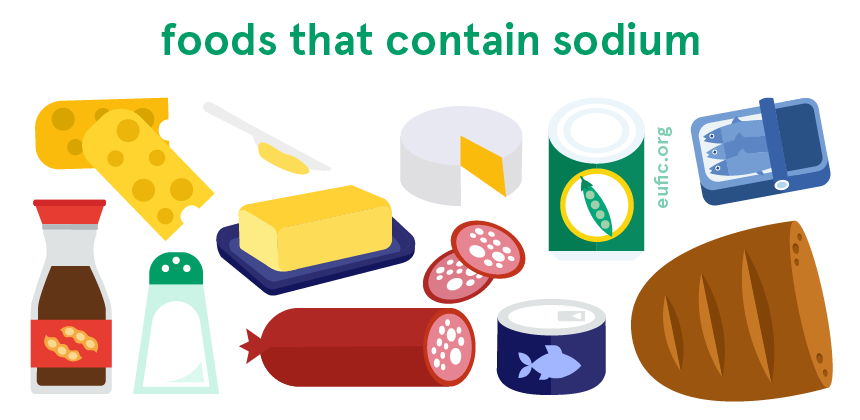Sodium: foods, functions, how much do you need & more
Last Updated : 11 January 2021Just a pinch of table salt can contain up to 400 mg of sodium, but this mineral is naturally present in many other foods. While sodium does a lot of good for our bodies, too much of it can get us in trouble.
What is sodium?
Sodium is one of the major minerals, which our bodies need in relatively larger amounts to keep healthy. We can find sodium naturally in a variety of foods, but it’s often common that we have it as sodium chloride, also known as table salt.
What are the functions of sodium?
One of sodium’s main functions is to balance the amount and distribution of water in our bodies, playing a key role in the control of our blood pressure.
Similar to chloride and potassium, sodium creates specific channels in the membranes of our cells which carry out different vital tasks. For example, sodium channels help to control the amount of water that gets in and out of cells and allow the transport of specific nutrients and compounds (such as amino acids, glucose, vitamins, etc.) into the cells. Sodium is also important to help our muscles and heart contract and to allow our nerve cells to carry messages (nerve impulses) between the brain and the body.

How much sodium do I need per day?
How much sodium you need per day changes according to your age, sex and life-stage.
The dietary reference value (DRV)* for healthy adults (over the age of 18), including during pregnancy and lactation, is 2 g of sodium per day. This translates roughly to 5 g, or a teaspoon of table salt (sodium chloride), which is our main source of sodium in the diet.
Similar to chloride, the recommended amount for sodium is considered both safe and adequate, which means it’s enough to meet our bodies’ needs while preventing us from having a higher risk of specific health consequences linked to diets high in sodium chloride, such as higher blood pressure and cardiovascular diseases.
Following your country's dietary guidelines on a healthy and balanced diet, particularly in regard to salt intake, will help you meet your needs for sodium without risking exceeding the recommended amounts.

* These values are based on the safe and adequate intake estimates from the European Food Safety Authority (EFSA). They should not be interpreted as nutrient goals. To know more about DRVs in Europe click here.
What foods contain sodium?
Sodium is naturally found in all unprocessed foods, although in very small amounts. For example, raw meat and fish can contain between 30 to 150 mg per 100 g of food, while fruits and vegetables usually have less than 50 mg per 100 g of food. Sodium is also found in drinking water, but in varying amounts depending on the country and the type of substances used in the water treatment.
Yet it’s the sodium added to foods as table salt or through food additives (during cooking or food processing), that most contributes to our daily intake of this mineral, often in excessive amounts.
Some examples of foods high in sodium are shown in the image below and include:
- food sauces (such as soy sauce)
- processed meats (such as ham, bacon, sausages, etc.)
- cheese
- canned fish.
It’s important to moderate the intake of foods high in salt and opt for versions have are low in (< 0.3 g of salt per 100 g of food) or have no added salt. Remember that a single teaspoon of table salt (5 g) is enough to meet our daily recommended amounts for sodium (and chloride).

Does sodium interact with other nutrients?
Sodium interacts with chloride and potassium in helping to regulate the volume of water in the body and to support the normal function of our muscle’ and nerve cells. Having the right balance of these three minerals in our diets – particularly by making sure we eat enough potassium and keep our salt intake within the recommended values – is key to support a healthy blood pressure.
Diets high in sodium also impair the calcium balance in the body, since our bodies use the calcium stored in our bones to help remove the extra sodium through urine. As so, keeping low intakes of salt (our main source of sodium in the diet) is important not only to lower the risk of cardiovascular diseases, but also to protect the health of our bones.
What happens if I have too little sodium?
It’s not common to have too little sodium in our diets since this mineral is present in most foods.
Sodium deficiency is mainly associated with metabolic disorders or specific health conditions (such as severe episodes of diarrhoea or kidney malfunction) that cause our bodies to remove excessive amounts of this mineral.
What happens if I have too much sodium?
The maximum recommended daily intake for sodium is 2 g, which is roughly equivalent to a teaspoon of table salt. However, it’s important to keep in mind that table salt is often added to many foods during processing, making it easy for us to exceed the recommended amounts.
Regularly exceeding this recommendation puts us at risk of having high blood pressure, which in turn can lead to cardiovascular and/or kidney disease.
When should I pay extra attention to my sodium intake?
Sodium deficiency is not a risk for the general population with a varied and balanced diet.
References
- European Food Safety Authority. 2019. Scientific Opinion on the dietary reference values for sodium. EFSA Journal 2019;17(9):5778
- Public Health England. 2019. McCance and Widdowson’s Composition of Foods Integrated Dataset.



